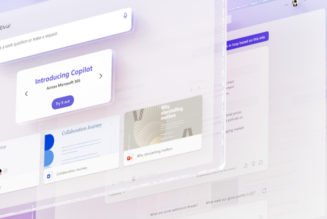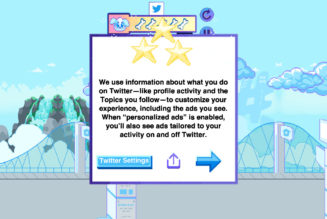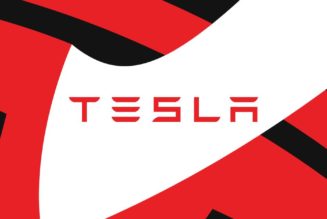British Satellite broadcaster Sky is moving away from the satellite dishes that have defined its TV service for decades. Sky Glass is launching today, an ambitious effort to sell television sets that stream Sky TV content over Wi-Fi directly to consumers. There’s no external box, no satellite dish, and no need for a soundbar. Sky calls the all-in-one TV “no fuss.”
Although announced for the UK today, Sky has global aspirations for Glass TV “built on technology borne of the collaboration as part of the Comcast Corporation.” As such, we might be looking at the platform underpinning Comcast’s rumored XClass TVs for the US.
Sky Glass TVs will be available in three sizes: 43-inch, 55-inch, and 65-inch. Each 4K TV will stream Sky’s TV channels, and integrates in voice control (Hello Sky) and 21 apps to access additional content like Netflix, Spotify, or Disney Plus. Sky hasn’t named the TV manufacturer it partnered with yet, but the full specifications include a UHD Quantum Dot display, support for Dolby Vision, HDR 10, HLG, three HDMI 2.1 ports, and a single USB-C port. The rather chubby TV fits six speakers for up to 215W of Dolby Atmos surround sound: 3 outward firing speakers, 2 upward, and 1 central subwoofer. There will also be five color options: white, pink, green, blue, and black.
:no_upscale()/cdn.vox-cdn.com/uploads/chorus_asset/file/22907030/skyglasstvs.jpg)
:no_upscale()/cdn.vox-cdn.com/uploads/chorus_asset/file/22907031/Sky_Glass_Voice_remote___lifestyle__TV_in_action.jpg)
The price of a Sky Glass TV is designed to be baked into a monthly subscription to Sky’s TV service, known as Sky Ultimate TV, but you can also pay for the TV upfront if you want to lower the monthly costs. Sky Ultimate TV includes access to Netflix and some basic Sky channels, but Sky Sports and Sky Cinema are separate add-ons. What you pay will depend on the size of TV and whether you want to spread payments.
The smallest 43-inch model is £649 upfront, or you can spread the payments at £13 per month over 48 months, or £26 per month over 24 months. The 55-inch model works out at £849 upfront, or £17 per month over 48 months, and £34 per month over 24 months. The largest 65-inch Sky Glass TV is £1,049 upfront, or £21 per month over 48 months, and £42 per month over 24 months.
That means the cheapest option for a Sky Glass TV is £39 per month for the smaller 43-inch model, unless you’re willing to pay for it upfront and pay the £26 per month subscription separately. Sky has full pricing options here.
:no_upscale()/cdn.vox-cdn.com/uploads/chorus_asset/file/22907039/skyglasspucksandremote.jpg)
Sky is also offering Sky Stream pucks at £50 each upfront, which you can use in other rooms of your house to stream Sky content to existing TVs. These appear to be offered only as add-ons, much like Sky’s multiscreen offering, so you can’t purchase a Sky Stream puck without a Sky Glass TV. Sky Steam pucks will also require a £10 monthly subscription.
Sky describes its new Glass TVs as a “voice-first” platform, so while there is a separate remote, the company is pushing voice commands more than ever before. “Hello Sky” activates Sky’s voice commands, much like a digital assistant, and you’ll even be able to use it to switch HDMI ports by saying “Sky, Xbox” to switch to an Xbox console if you have one connected.
Sky is also working on a 4K smart camera that will attach to its Sky Glass TVs and will launch in 2022. It looks a lot like Microsoft’s Kinect camera, and it even includes body tracking and motion controls just like Kinect. Sky boldly claims it will “transform how we chat, play games, workout, and share entertainment at home.” It will support apps like Zoom, and includes noise-cancellation.
:no_upscale()/cdn.vox-cdn.com/uploads/chorus_asset/file/22907038/skyglasscamera.jpg)
The most interesting aspect of the camera is Sky’s collaboration with Microsoft to watch TV together with others. Sky demonstrated a software experience that allows you to watch TV channels with others, and see each other’s reactions to sport in real time. This is something Microsoft always wanted to deliver through its Kinect work, so it’s interesting to see the company with Sky.
This camera includes motion controls, allowing Sky Glass owners to access “family games” and control them with their body. This was always the dream of Kinect on Xbox, and it looks like Sky is trying to resurrect it with Sky Glass TVs.
While Sky has detailed its hardware today, we’re still waiting to hear more on how the company is streaming its content over the web. TV providers have struggled to stream live TV without a delay over the internet, which is particularly jarring when you’re watching live sport and neighbors cheer or you see the score on Twitter before it happens on your screen.
Sky says you’ll need a minimum connection of 10Mbps to stream HD content through a Sky Glass TV, or 25Mbps for 4K. That’s identical to the minimums for Netflix, but Sky hasn’t detailed what bitrates and streaming protocols it’s using yet.
:no_upscale()/cdn.vox-cdn.com/uploads/chorus_asset/file/22907034/white3.png)
Sky also says it will be the first TV manufacturer in the world to have a swap program, allowing customers to swap old Sky Glass TVs for newer models when they’re available. It’s not immediately clear how that will work, but it will likely only be offered to those who spread the cost in Sky’s monthly subscriptions instead of buying the TV upfront.
Sky Glass won’t be limited to the UK, either. Sky has built these TVs so other telcos and television operators can launch Sky Glass TVs, too. Australia’s Foxtel Group will launch Sky Glass at some point in the future, and Sky says this is the “first of many collaborations as Sky Glass is scaled across the globe.”
Sky Glass TVs could also form the basis of Comcast’s XClass TVs, as Sky notes its TVs are “built on technology borne of the collaboration as part of the Comcast Corporation.” Rumors suggest Comcast’s upcoming TVs will run Comcast’s X1 OS.
Disclosure: Comcast is an investor in Vox Media, The Verge’s parent company.









